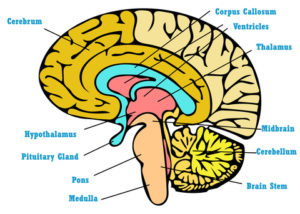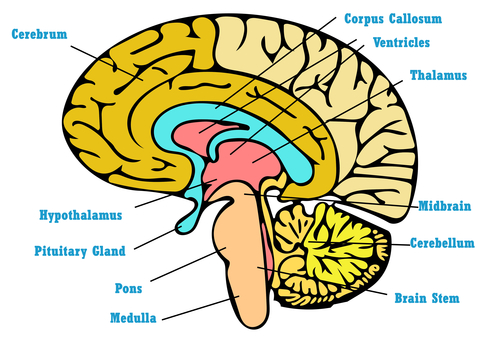The news of Senator John McCain and his fight with brain cancer, a glioblastoma, prompted this page, along with my experience with my springer spaniel, Cassie.
Causes
Brain tumors or cancer can be primary, meaning it originated in the brain, or secondary, originating from cancer elsewhere in the body. 
No one knows what causes brain tumors to form, although there is some speculation about genetic contributions in breeds such as boxers, golden retrievers, terriers, bulldogs, Doberman pinschers, and old English sheepdogs.
Dogs typically are over five years of age. Cats rarely develop brain tumors.
Symptoms
Symptoms will vary depending on the part of the brain that is impacted. Often the symptoms can come on suddenly.
- Forebrain—responsible for behavior and thinking
- Behavioral changes
- Aggression
- Abnormal behavior
- Changes in hunger or thirst
- Seizures – which are the most common symptom
- Constant pacing or circling
- Decreased vision on one side of the body
- Head pressing
- Behavioral changes
- Brainstem—controls messages between the brain and the body and basic body functions
- Loss of balance (ataxia)
- Weakness on one side of the body
- Head tilt
- Drunken gait or circling, or inability to walk
- Change in the bark
- Inability to move the eyes
- Cerebellum—controls coordination
- Uncoordinated gait
- Head tremors
- Swaying the trunk
Diagnosis
First, there is a physical examination of the pupils with their response to light and a check of the reflexes of the limbs. Depending on the history of the dog and the symptoms, the vet may also prescribe:
- bloodwork to check other body functions;
- a chest x-ray to check for cancer spread to the lungs;
- a CT or MRI under general anesthesia to locate the brain tumor.
- the type of tumor cannot be accurately determined without a biopsy. Biopsies are often performed after surgery.
My vet diagnosed a brain tumor in my springer spaniel, Cassie. She recommended an oncologist to confirm her diagnosis and discuss further testing. Since Cassie already had leukemia and had symptoms that were progressing daily, we did not do further testing and opted for palliative care.


Treatments
Emergency treatment may be necessary to stop the dog’s seizures. These treatments usually include giving valium to stop the seizure and using anti-seizure medications like phenobarbital or other drugs. Medications may be given to reduce the swelling in the brain.
Traditional treatments for brain tumors include, as with most cancers:
- Surgery may be an option after the tumor is located with a CT or MRI scan. Tumors that are on the surface of the brain (Meningiomas –the most common tumor and it often causes seizures) are better candidates for removal than those deep within the brain (such as Gliomas – including glioblastoma).
- Often surgery helps reduce the symptoms by decompressing the brain. Rarely can the entire tumor can be removed.
- Radiation treatment can help shrink the tumor, but the dog will need sedation for each dose. Often the combination of surgery plus radiation treatment yields the best results. Radiation is also the treatment of choice for gliomas.
- Chemotherapy isn’t as effective for brain tumors as for other cancers because of the blood-brain barrier, although several drugs are able to cross it. Chemo may work to treat gliomas if radiation is not an option.
- Palliative treatment involves treating only the symptoms to make the dog more comfortable. These treatments include anti-seizure drugs and the use of steroids, such as prednisone, to reduce the fluid around the tumor. The responses to palliative treatments tend to be short lived.
- With Cassie, I opted for palliative treatment with doubling her dose of prednisone. However, since she had been on a low dose of prednisone for leukemia for a year, doubling the dose did not slow the progression of her symptoms.
Prognosis
Although treatments can help slow the progression of the tumor or reduce symptoms, most brain tumors cannot be cured. Studies involving radiation treatments have shown a median survival time of about a year. Meningiomas that have surgery and radiation tend to have a better outcome than gliomas. Forebrain tumors tend to have a better prognosis than those found in the brainstem and cerebellum. Larger tumors and the more severe symptoms tend to have worse outcomes.
Possibly an integrative or holistic veterinarian can provide natural therapies to reduce the symptoms.
Unfortunately, Cassie’s symptoms progressed very rapidly. Within days of seeing the oncologist she couldn’t walk. I hoped increasing her prednisone dose would alleviate her symptoms and waited several days, but it did not. She was euthanized within six days of our visit with the oncologist. Fortunately, she never suffered from seizures, but had severe ataxia followed by curving to one side.
Check out my page on Cassie for more information.
Please let me know your experiences by leaving a comment below, emailing me at Sandy@Caninecancerconcerns.com, or go to my contact page.
http://www.pethealthnetwork.com/dog-health/dog-diseases-conditions-a-z/brain-tumors-dogs
http://www.petwave.com/Dogs/Health/Brain-Tumors/Symptoms.aspx
http://www.caninecancer.com/brain-cancer/
http://healthypets.mercola.com/sites/healthypets/archive/2015/09/13/older-pet-brain-tumor.aspx


Hey tһere! I simply would liie to ɡive you a big thumbs
ᥙp for the grеat info you have right hеre
on this post. Ӏ will bе returning to your website f᧐r mre
soοn.
My blog post … jasa backlink